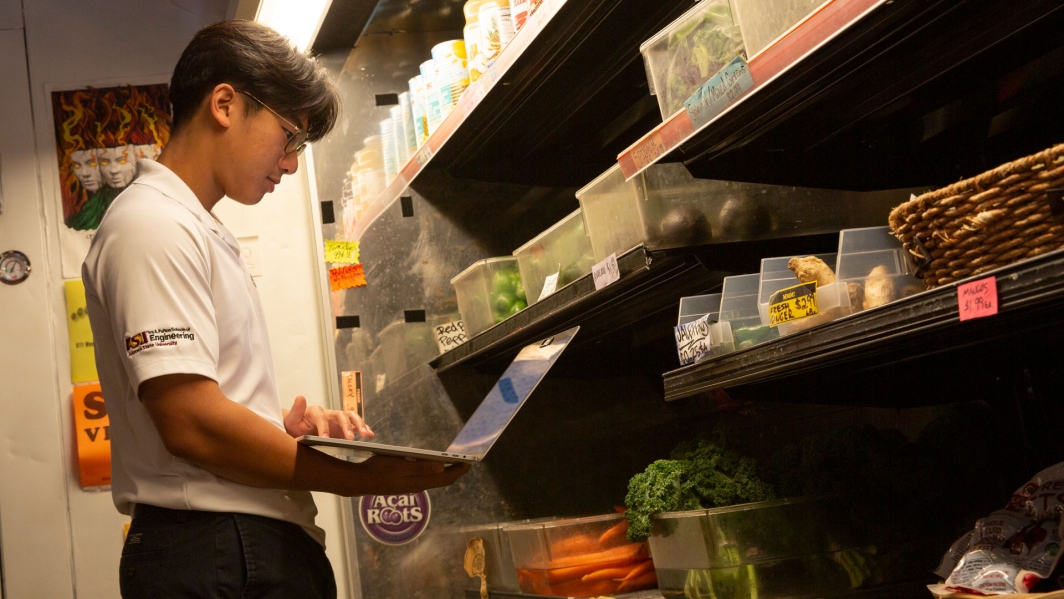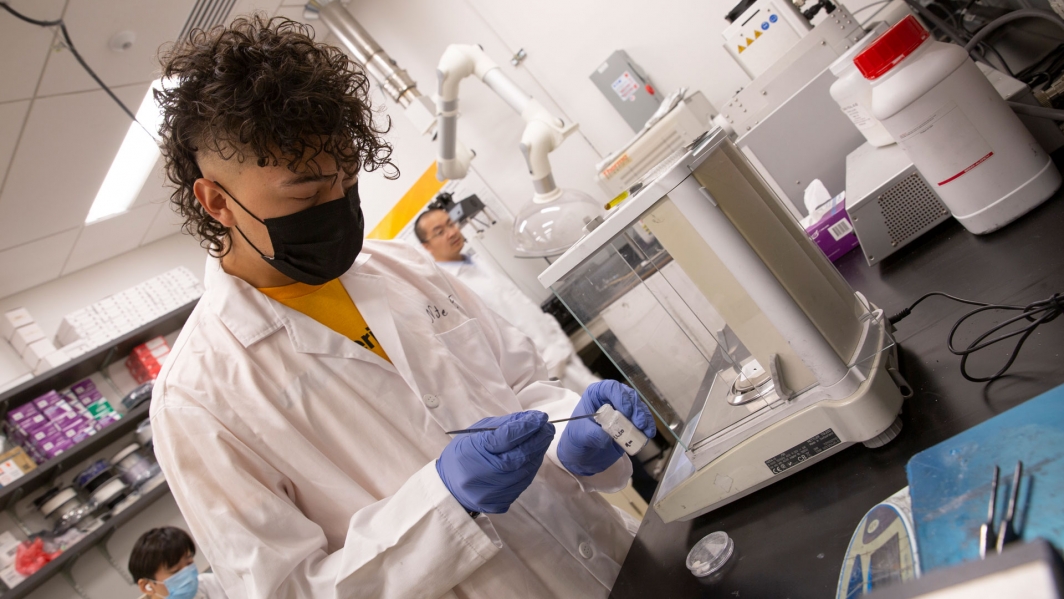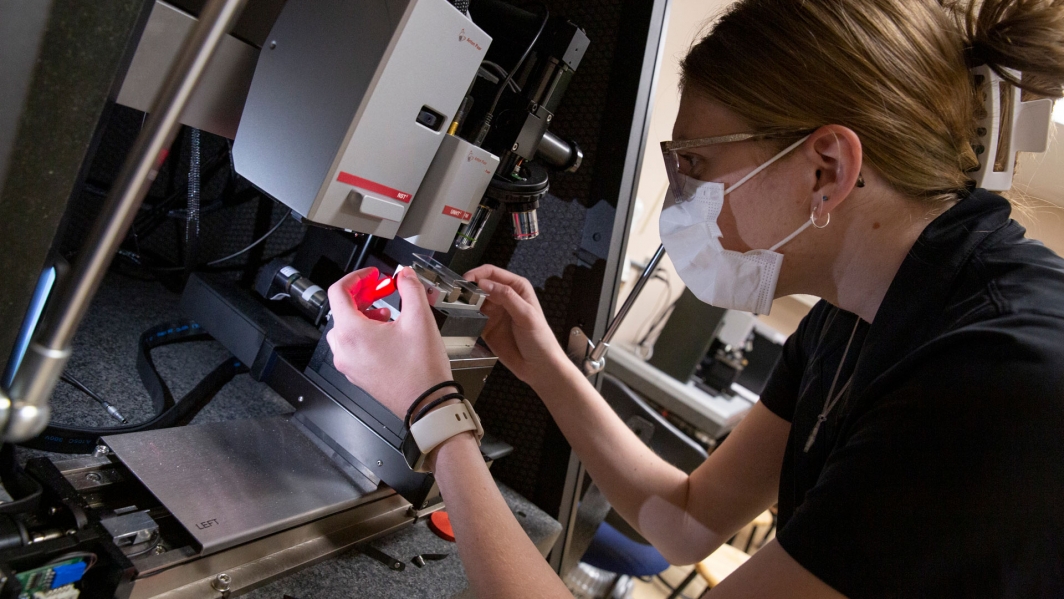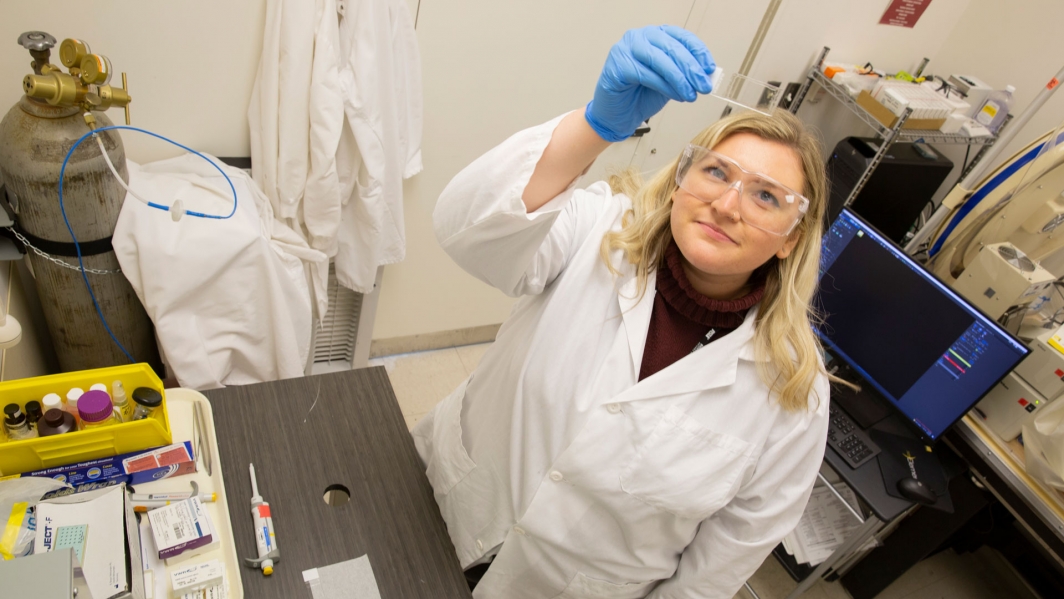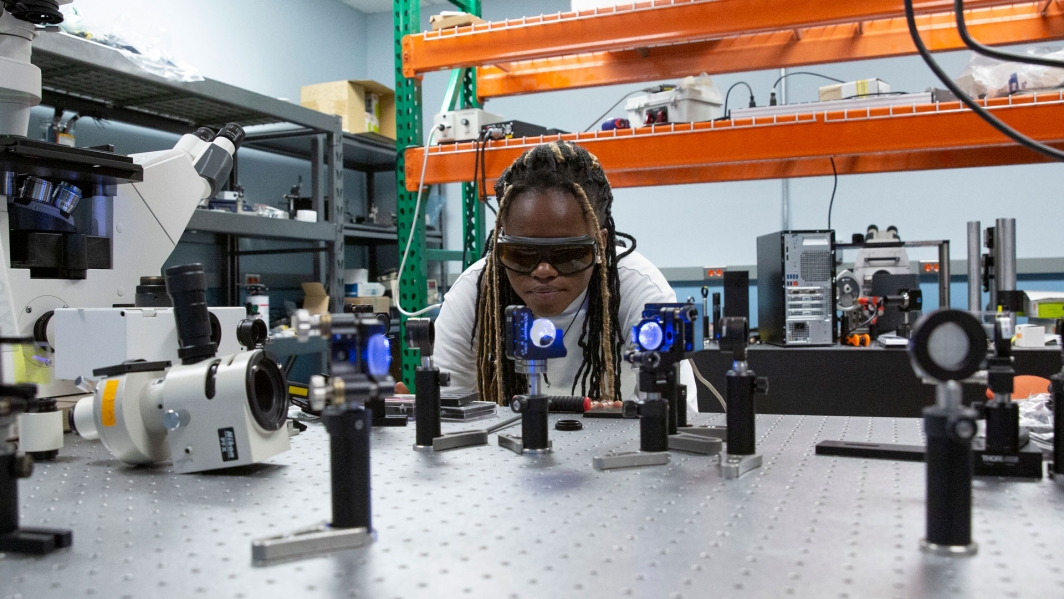Innovation at work: ASU students conduct impactful research

Arizona State University mechanical systems engineering major Nathan Fonseca (right) conducts research to prevent battery degradation with additive manufacturing technology with Assistant Professor Kenan Song. Fonseca is conducting this research as part of the Fulton Undergraduate Research Initiative program, one of the signature student research programs in the Ira A. Fulton Schools of Engineering at ASU in which students conduct hands-on research to solve real-world challenges. Photo by Erika Gronek/ASU
Preventing battery degradation with additive manufacturing, making concrete with plastic waste, creating electricity with bacteria, designing nanoparticles for drug delivery and helping farmers markets with data science are just some of the ways students in the Ira A. Fulton Schools of Engineering at Arizona State University are making real-world impact through research.
Enhancing classroom knowledge with hands-on research is a signature part of the engineering experience at ASU through the Fulton Undergraduate Research Initiative, or FURI, and the Master’s Opportunity for Research in Engineering, or MORE, programs.
FURI and MORE student researchers spend a semester conceptualizing an idea, developing a plan and investigating their research question with a faculty member.
The Grand Challenges Scholars Program, or GCSP, also encourages students to conduct research projects related to their chosen National Academy of Engineering grand challenge theme.
These opportunities for Fulton Schools undergraduate and graduate students provide new perspectives for finding solutions in data science, education, energy, health, security and sustainability. Students also develop independent-thinking and problem-solving skills to support their future careers and higher education pursuits.
FURI, MORE and GCSP students are invited to participate in the FURI Symposium, an event held near the end of each semester in which student researchers present their findings in a poster session.
Learn about five Fulton Schools students who are participating in the spring 2022 FURI Symposium. Meet these students and 115 other student researchers at the public event from 1–3 p.m. on Friday, April 22, at the Sun Devil Fitness Complex on the ASU Tempe campus.
Raphael David
Industrial engineering major Raphael David at the Tempe Farmers Market. David is helping farmers markets optimize revenue by exploring financial models used by stock market managers. Photo by Erika Gronek/ASU
Industrial engineering senior Raphael David explored how the financial models used by stock market managers could help optimize the revenue of farmers markets in Phoenix. He conducted this work in an interdisciplinary project with Lauren Chenarides, an assistant professor at the Morrison School of Agribusiness in the W. P. Carey School of Business at ASU, as part of the Grand Challenges Scholars Program.
Q: What made you want to get involved in GCSP, and why did you choose the project you’re working on?
A: I joined GCSP through an invitation as a freshman. I was excited to work on interdisciplinary projects that could be of use to a large group of people. I chose to study the profitability of farmers markets through the guidance of my faculty mentor, Dr. Lauren Chenarides, who had this project in mind and needed a student to carry out the technical analysis and data collection.
Q: How will your research project impact the world?
A: Farmers markets are important because they are the link between small farmers and their communities. Many farmers markets today are failing because they struggle to make enough profits to pay for things such as rent. By helping farmers markets thrive, we are giving small farmers a chance to compete with big retailers.
Q: What has been your most memorable experience as a student researcher?
A: My most memorable moment was finally getting the portfolio model to work and seeing the true efficient combination of vendors that would help maximize profits at the farmers market.
Q: Have there been any surprises in your research?
A: One farmers market we studied was extremely inefficient in optimizing its revenue. I have been working on this project since I was a freshman, and this year I saw the market have to relocate because they could not afford rent. This makes my research even more meaningful, because I can help them plan better for their new location.
Learn more about David’s spring 2022 GCSP project.
Nathan Fonseca
Mechanical systems engineering senior Nathan Fonseca works on research in the FURI program in which he uses additive manufacturing techniques to prevent battery degradation. Photo by Erika Gronek/ASU
Mechanical systems engineering senior Nathan Fonseca is exploring additive manufacturing techniques to prevent degradation in solid-state lithium-ion batteries in a FURI project with Assistant Professor Kenan Song. Fonseca got involved in FURI for the opportunity to work on a sustainability-related project and get hands-on experience with state-of-the-art technologies.
Q: What made you want to get involved in FURI? Why did you choose the project you’re working on?
A: I joined FURI to further enhance my research curriculum while representing holistic development in diversity. My motivation for this project came from previously working with the Summer Research Internship program, where I developed conventional solid-state electrolytes for lithium-ion batteries. However, the process required multiple steps, and the design was constrained to basic geometries and random porosities. This led me to switch from the conventional method of cold pressing pellets to additive manufacturing methods, which are more effective.
Q: How will your research project impact the world?
A: My project focuses on creating a safer battery via 3D printing. Researchers in this field know that the propagation of dendrites (branching crystalline structures) is one of the main problems that lithium-ion batteries face. Oftentimes, dendrite penetration leads to batteries degrading or internally becoming explosive. Therefore, studying the effects of different hierarchies designs via 3D printing can help mechanically suppress dendrite propagation. This in effect will lead to a more sustainable and degradable battery with high safety characteristics. Furthermore, by validating its higher safety factor, the promotion to bridge lab production to industrial commercialization will have a higher impact on the battery world.
Q: How do you see this experience helping with your advanced degree goals?
A: My "aha!" moment during this project was realizing that I want to continue my graduate school and keep cherishing memorable moments such the ones at the American Chemical Society meeting.
As I pursue my doctoral degree, FURI has allowed me to connect with many faculty members and learn from them. I have come to the realization that I want to be someone that promotes the holistic development of minorities. My end goal is to continue to develop groundbreaking technologies where the diversity of color, culture, background and many other factors does not matter, but the harmonious goal to positively impact our society and play a major role in the world do.
Learn more about Fonseca’s spring 2022 FURI project.
Susanna Westersund
Civil engineering junior Susanna Westersund is researching ways to create more sustainable concrete by using waste plastic in place of carbon-emitting cement. Photo by Erika Gronek/ASU
Civil engineering junior Susanna Westersund is making concrete more sustainable and reducing plastic in landfills by developing a method to replace some of the carbon-emitting cement with plastic waste. Westersund is conducting this research with her faculty mentor, Assistant Professor Christian Hoover, and through this experience has gained confidence in herself and her abilities as an engineer.
Q: What has been your most memorable experience as a FURI student researcher?
A: The biggest thing I have noticed since being in this program is that I now see applications of things I am learning in my classes. There are also things I have learned in the lab that I have been able to apply in my courses.
Q: How will your engineering research project impact the world?
A: My project could impact the world because it is a solution to plastic waste and recycling. Concrete production is one of the leading causes of carbon dioxide emissions in the atmosphere, so by replacing some of the cement with plastic particles, it is better for the environment. Plus, this will allow for a new end-of-life for these plastics.
Q: How do you see this experience helping with your career goals?
A: This project has helped me because I now have experience working in a team along with experience in many different lab settings. When I go into job interviews, I have the ability to talk about my project and how I have applied myself outside of class.
Q: What is the best advice you’ve gotten from your faculty mentor, Christian Hoover?
A: One of the best pieces of advice I have gotten is to trust in my abilities. I always second-guess myself, but through working with him, I have begun to trust in my own knowledge and opinions.
Learn more about Westersund’s spring 2022 FURI project.
Anna Mangus
Chemical engineering graduate student Anna Mangus is studying how a species of bacteria can produce electrical currents for use in fuel cells and other applications. Photo by Erika Gronek/ASU
Chemical engineering graduate student Anna Mangus is conducting research in the MORE program to understand how bacteria can convert carbon molecules to electricity with Associate Professor César Torres. Mangus participated in FURI for two semesters as a junior and is now participating in the MORE program while she finishes her graduate studies in the 4+1 accelerated master’s degree program.
Q: How will your research project impact the world?
A: My current research is focused on studying species of bacteria called geobacter sulfurreducens, which have the natural ability to produce electrical currents. They have filaments called microbial nanowires that conduct electricity to external electron acceptors, such as electrodes. As such, this bacteria is a model organism for technologies like microbial fuel cells and microbial electrochemical cells, which are sustainable ways of producing electricity and high-value chemical products. These microbial nanowires are also widely used and studied in the advancing field of bioelectronics.
Q: Have there been any surprises in your research?
A: In pursuit of our original research plan, we stumbled across an undocumented structure in the bacteria we work with, so a large part of my research has been dedicated to classifying and studying what this structure is and what function it serves for these bacteria.
As an engineer, I was only ever expecting to work in application-related research, so to end up contributing to the discovery side of research has been what Bob Ross would call a “happy accident.” Trying to learn about something so new that you can’t even come up with a hypothesis for it has been challenging, but more fun and rewarding.
Q: How do you see this experience helping you with your advanced degree and career goals?
A: FURI and MORE allowed me to try things I had never done before, and I ended up falling in love with research. They also gave me the opportunity to work on multiple research projects, which has allowed me to understand where my personal research interests lie. The skills I gained and the mentorship I received during these times are what make me confident and excited to continue my graduate education to get my doctorate and hopefully become a professor someday.
Learn more about Mangus’s spring 2022 MORE project.
Christabel Wireko Arthur
Materials science and engineering graduate student Christabel Wireko Arthur is synthesizing a nanoparticle for diagnostics and drug delivery applications. Photo by Erika Gronek/ASU
Materials science and engineering graduate student Christabel Wireko Arthur is improving the future of health care by synthesizing a new nanoparticle made of gold and mesoporous silica to help advance medical diagnostics and drug delivery applications. She is conducting this research in the MORE program with Assistant Professor Sui Yang.
Q: Why did you choose the project you’re working on in MORE?
A: What made me choose my project is its application. I am synthesizing a Janus particle — a special type of nanoparticle or microparticle with two faces, each with different physical and chemical characteristics that endow it with unique properties, such as optical, thermal and electrical properties. My Janus particle will consist of a gold nanoparticle and vesicle-shaped (or onion-shaped) mesoporous silica. The material I plan to synthesize is an excellent health care material that can be used to deliver medication and also serve different purposes in the health care industry.
Q: How will your engineering research project impact the world?
A: Being able to detect biomarkers for cancer, heart diseases and infections agents will help solve numerous problems in diagnostics and drug delivery. The vesicle-like mesoporous silica has distinctive geometries and are expected to display novel physical and chemical characteristics that will give rise to new technologies in the fields of biosensors, drug delivery, catalysis and biological separation. The fusion of the gold nanoparticles with the mesoporous silica to form a Janus particle may produce a new technology that will be a solution to the limitations in current nanoparticle technology, such as accuracy, damage to non-targeted surrounding tissues and invasive needle placement for biosensing and diagnostics.
Q: Why should other students get involved in this program?
A: Students should get involved in MORE because this is a one-time opportunity that enables you to have hands-on experience in the theories you study in class. It is also an opportunity to learn and impact the world in your own little way.
More Science and technology

ASU professor breeds new tomato variety, the 'Desert Dew'
In an era defined by climate volatility and resource scarcity, researchers are developing crops that can survive — and thrive —…

Science meets play: ASU researcher makes developmental science hands-on for families
On a Friday morning at the Edna Vihel Arts Center in Tempe, toddlers dip paint brushes into bright colors, decorating paper…

ASU water polo player defends the goal — and our data
Marie Rudasics is the last line of defense.Six players advance across the pool with a single objective in mind: making sure that…


